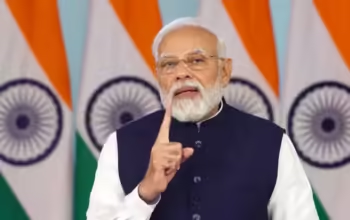Introduction to Modi’s 3.0 Cabinet
Prime Minister Narendra Modi’s third term in office, often referred to as Modi 3.0, marks a pivotal moment in India’s political landscape. Following a decisive victory in the 2024 general elections, Modi’s new cabinet reflects a blend of continuity and change, designed to address both emerging challenges and longstanding issues. The political landscape leading up to the elections was characterized by robust campaigning, with major promises aimed at economic revitalization, social equity, and national security.
The Modi 3.0 cabinet is expected to play a crucial role in shaping India’s future, with a significant emphasis on sectors such as micro, small, and medium enterprises (MSMEs), which are seen as the backbone of the Indian economy. During the campaign, Modi highlighted the importance of bolstering the MSME sector to drive job creation, innovation, and entrepreneurship. This promise resonated with a wide spectrum of voters, particularly those in rural and semi-urban areas where MSMEs are a dominant force.
Expectations from the new government are high, given the diverse and ambitious agenda set forth during the campaign. Key areas of focus include economic reforms aimed at fostering growth and investment, enhancing infrastructure, and improving ease of doing business. Social initiatives targeting healthcare, education, and women’s empowerment are also anticipated to be at the forefront of the government’s priorities.
The significance of Modi’s third term extends beyond economic measures. It is also seen as a mandate for strengthening India’s global standing, with a foreign policy that balances strategic alliances and regional stability. The new cabinet is expected to navigate complex international relations while promoting India’s interests on the global stage.
As Modi 3.0 embarks on this new journey, the cabinet’s composition and policy direction will be closely watched by both domestic and international stakeholders. The government’s ability to deliver on its promises will be critical in shaping India’s trajectory over the next five years and beyond.
Key Members of the Modi 3.0 Cabinet
The Modi 3.0 Cabinet showcases a blend of experienced politicians and fresh faces, reflecting a strategic balance aimed at steering India towards robust governance and comprehensive development. At the forefront is Amit Shah, who continues to serve as the Home Minister. Shah, a close confidant of Prime Minister Narendra Modi, has been instrumental in driving key policies such as the abrogation of Article 370 and the introduction of the Citizenship Amendment Act. His tenure is marked by a focus on national security and internal affairs, and he is expected to further intensify efforts in these domains.
Nirmala Sitharaman retains her position as Finance Minister. Known for her adept handling of the economy during unprecedented challenges such as the COVID-19 pandemic, Sitharaman’s role is crucial for India’s financial stability and growth. Her initiatives, including the Atmanirbhar Bharat Abhiyan, have laid the groundwork for self-reliance and economic resilience. The continuation of her policies is anticipated to foster economic recovery and expansion.
Among the new faces, Jyotiraditya Scindia’s appointment as the Minister of Civil Aviation stands out. Scindia, a former Congress leader who joined the Bharatiya Janata Party in 2020, brings a fresh perspective to the ministry. His experience in various political roles and his dynamic approach are expected to invigorate the aviation sector, which is pivotal for India’s connectivity and economic infrastructure.
Another notable inclusion is Sarbananda Sonowal, the former Chief Minister of Assam, who takes on the role of Minister of Ports, Shipping and Waterways, and Ayush. Sonowal’s administrative acumen and focus on regional development are likely to enhance maritime infrastructure and traditional healthcare systems, contributing to holistic national growth.
Dr. S. Jaishankar continues as the Minister of External Affairs, bringing his extensive diplomatic experience to the fore. Known for his strategic insights and global outlook, Jaishankar’s tenure has seen India fortify its international relationships and assert its stance on key global issues. His ongoing efforts will be essential in navigating the complexities of international diplomacy.
These key members, with their diverse backgrounds and strategic roles, form the backbone of the Modi 3.0 Cabinet. Their collective expertise and vision are geared towards propelling India towards a trajectory of inclusive growth and robust governance, ensuring that the government’s objectives are met with precision and effectiveness.
Major Changes in Ministry Portfolios
The Modi 3.0 cabinet has witnessed substantial reshuffling in ministerial portfolios, marking a strategic pivot in the government’s approach to governance and policy implementation. A notable change is the reallocation of key economic and social sector ministries, reflecting a targeted focus on rejuvenating the Micro, Small, and Medium Enterprises (MSME) sector alongside other pivotal areas.
In comparison to the previous cabinet, several high-profile ministries have seen new leadership. For instance, the Ministry of Finance, previously under Nirmala Sitharaman, now has a new head who brings a fresh perspective on economic reforms and fiscal policies. This change is anticipated to drive a more aggressive push towards economic recovery and resilience, especially in the post-pandemic scenario.
Similarly, the Ministry of Education has undergone a leadership change, which is expected to infuse new energy into the ongoing education reforms. The new minister’s background in grassroots educational initiatives suggests a shift towards more inclusive and accessible education policies, aiming to bridge the urban-rural divide. This realignment is crucial for nurturing a skilled workforce that supports the MSME sector’s growth.
The Ministry of Health and Family Welfare also sees a new leader, highlighting the government’s continued emphasis on public health in the wake of COVID-19. The new minister’s experience in public health administration is expected to bolster the nation’s healthcare infrastructure and readiness for future health crises.
Moreover, the Ministry of Commerce and Industry has been restructured to better align with the government’s vision of an ‘Atmanirbhar Bharat’ (self-reliant India). The new appointee’s expertise in international trade and domestic market dynamics is likely to foster a more robust MSME sector, enhancing its global competitiveness.
These shifts in ministerial portfolios are driven by strategic objectives, aiming to streamline governance and ensure more effective policy implementation. The new leaders, chosen for their specialized expertise and innovative approaches, are expected to invigorate their respective sectors. Consequently, these changes could lead to more coherent and responsive governance, ultimately benefiting various sectors, including the crucial MSME industry.
Focus on MSMEs: Policy and Initiatives
The Micro, Small, and Medium Enterprises (MSMEs) sector plays a pivotal role in India’s economy, contributing significantly to employment generation, industrial output, and exports. Comprising over 63 million units, MSMEs account for approximately 45% of the manufacturing output and 40% of the total exports. Recognizing the sector’s importance, the Modi government has strategically focused on bolstering MSMEs to ensure sustained economic growth and resilience.
The challenges faced by MSMEs are multifaceted, ranging from limited access to credit and technology to regulatory bottlenecks and inadequate infrastructure. To address these issues, the Modi 3.0 cabinet has rolled out a series of targeted policies and initiatives aimed at fostering a more conducive environment for MSMEs to thrive.
One of the cornerstone initiatives is the “Atmanirbhar Bharat Abhiyan” (Self-Reliant India Campaign), which seeks to make India self-sufficient by promoting local manufacturing and reducing dependency on imports. Under this campaign, the government has introduced the Emergency Credit Line Guarantee Scheme (ECLGS) to provide collateral-free loans to MSMEs, helping them overcome liquidity crunches exacerbated by the COVID-19 pandemic.
Another key reform is the revision of the MSME definition, which now includes a wider range of businesses under its ambit. This reclassification facilitates easier access to government schemes and incentives. Additionally, the introduction of the Udyam Registration portal has simplified the registration process, enabling MSMEs to quickly and efficiently avail of various benefits.
The Modi government has also placed a strong emphasis on digital transformation through the Digital MSME initiative, which aims to enhance the digital capabilities of MSMEs. By promoting the adoption of cloud computing, artificial intelligence, and other advanced technologies, the initiative seeks to improve operational efficiency and market competitiveness.
Moreover, the “Make in India” and “Startup India” initiatives continue to provide substantial support to MSMEs by fostering innovation, encouraging entrepreneurship, and facilitating easier access to resources and markets. These initiatives are complemented by various state-level programs, creating a synergistic effect that amplifies the impact of national policies.
In essence, the Modi 3.0 cabinet’s focus on MSMEs reflects a comprehensive strategy to tackle existing challenges and unlock the sector’s potential. Through a combination of financial support, regulatory reforms, and technological advancements, the government aims to create a robust ecosystem that empowers MSMEs to drive India’s economic growth and development.
Economic Reforms and Their Impact on MSMEs
The Modi 3.0 government has introduced a series of economic reforms aimed at revitalizing India’s economy, with a keen focus on the Micro, Small, and Medium Enterprises (MSMEs) sector. Recognizing the pivotal role MSMEs play in employment generation and economic growth, these reforms are designed to create a more conducive business environment and enhance the sector’s competitiveness.
One of the cornerstone reforms is the comprehensive overhaul of the tax system. The introduction of the Goods and Services Tax (GST) has simplified the tax structure, providing MSMEs with a more transparent and uniform tax regime. Additionally, the reduction in corporate tax rates for MSMEs has alleviated the financial burden, enabling these enterprises to invest more in their growth and development.
Financial support schemes have also been a significant focus. The Emergency Credit Line Guarantee Scheme (ECLGS) has been extended, providing much-needed liquidity to MSMEs affected by the economic downturn. Furthermore, the establishment of the Fund of Funds for MSMEs aims to facilitate equity financing, which is crucial for the scaling of small businesses. These measures are expected to bolster the financial health and resilience of MSMEs.
Regulatory changes have been another critical area of reform. The Modi 3.0 government has streamlined compliance requirements, reducing the bureaucratic red tape that often hinders business operations. Initiatives such as the Udyam Registration portal have made it easier for MSMEs to formalize their business, thereby gaining access to various government benefits and subsidies.
While these reforms present significant opportunities for MSMEs, there are also challenges that need to be addressed. The transition to a new tax regime and compliance framework requires adaptation and learning, which can be resource-intensive for small businesses. Additionally, access to financial support may be uneven, with some MSMEs facing difficulties in meeting the eligibility criteria.
Overall, the economic reforms under Modi 3.0 hold the promise of creating a more vibrant and robust MSME sector. By addressing both the opportunities and challenges, the government aims to ensure that MSMEs can thrive and continue to be a driving force in India’s economic growth.
Live Updates and Analysis from NDTV
As the Modi 3.0 cabinet takes shape, NDTV and other credible news sources are providing comprehensive coverage of the latest developments. Key updates from NDTV include major announcements and policy changes that are set to define the new administration’s agenda. These updates are crucial for understanding the priorities and direction of Modi’s government as it embarks on its third term.
One of the most significant announcements is the focus on Micro, Small, and Medium Enterprises (MSMEs), which are expected to receive substantial support through new policies and initiatives. This focus aims to boost economic growth by empowering small businesses, which form the backbone of the Indian economy. Industry experts have largely welcomed this move, noting that enhanced support for MSMEs could lead to increased job creation and innovation.
The public reaction to the new cabinet has been mixed, with some expressing optimism about the continuity and stability that Modi’s leadership brings, while others remain skeptical about the implementation of promised reforms. Political analysts are closely watching the cabinet’s composition, which includes a blend of experienced leaders and fresh faces, to gauge how it will impact governance and policy execution.
NDTV’s live coverage includes real-time updates, expert analysis, and interviews with key stakeholders. For those seeking in-depth reports and live coverage, NDTV’s website offers a dedicated section that provides detailed insights into the unfolding events. Readers can stay informed by following the live updates and accessing various articles that delve deeper into the implications of the new cabinet’s policies.
For continuous and real-time information, readers are encouraged to visit NDTV’s live coverage and explore their extensive reports. This ongoing analysis will be crucial in understanding the immediate and long-term impacts of the Modi 3.0 administration.
Case Studies: Success Stories of MSMEs under Modi’s Leadership
The Modi administration has been instrumental in fostering the growth and development of Micro, Small, and Medium Enterprises (MSMEs) in India. Through a series of targeted policies and initiatives, the government has provided substantial support, enabling several MSMEs to thrive. Below, we highlight a few success stories that exemplify the practical impact of these efforts.
One notable success story is that of XYZ Textiles, a small textile manufacturing company based in Gujarat. Prior to the Modi administration’s reforms, XYZ Textiles struggled with limited access to credit and outdated technology. However, the introduction of the Pradhan Mantri Mudra Yojana (PMMY) provided them with the much-needed financial support. With a Mudra loan, XYZ Textiles invested in modern machinery, significantly enhancing production efficiency and quality. The company’s revenue has since doubled, and it has expanded its workforce, contributing to local economic development.
Another inspiring example is ABC Foods, a small-scale food processing unit located in Madhya Pradesh. Facing challenges in market access and compliance with food safety standards, ABC Foods benefited from the Modi government’s “One District, One Product” (ODOP) initiative. This program not only helped them streamline their production processes but also facilitated their entry into national and international markets. As a result, ABC Foods saw a 50% increase in sales and established a robust export network, showcasing the global potential of Indian MSMEs.
Additionally, the digital transformation of DEF Handicrafts, a traditional handicraft business in Rajasthan, underscores the role of government support. Leveraging the Digital India initiative, DEF Handicrafts created an online presence, reaching a broader customer base. The company also utilized the benefits of the Government e-Marketplace (GeM) to secure government contracts, boosting their revenue by 40%. This digital leap has positioned DEF Handicrafts as a competitive player in the handicraft industry.
These case studies illustrate how the Modi administration’s focus on MSMEs has facilitated their growth and success. By addressing key challenges such as access to finance, market reach, and compliance, the government’s policies have empowered these enterprises to overcome obstacles and achieve significant milestones. These success stories serve as a testament to the positive impact of the Modi 3.0 cabinet’s commitment to nurturing India’s MSME sector.
Future Outlook: What to Expect from Modi 3.0
The Modi 3.0 administration, with its renewed mandate, is poised to navigate a complex landscape of challenges and opportunities. Early actions and policy directions suggest a focus on sustainable economic growth, with a particular emphasis on Micro, Small, and Medium Enterprises (MSMEs). The government’s initiatives, such as the recently announced credit schemes and digital transformation programs, aim to fortify the backbone of the Indian economy, fostering innovation and enhancing competitiveness.
One of the notable strategies in Modi 3.0 is the continued emphasis on ‘Make in India’ and ‘Atmanirbhar Bharat’ (self-reliant India) campaigns. These initiatives are expected to provide significant impetus to domestic manufacturing and reduce dependency on imports, thereby strengthening MSMEs. However, the success of these programs will largely depend on the government’s ability to streamline regulatory frameworks and ensure ease of doing business.
Experts predict that the Modi 3.0 government will likely face substantial challenges, particularly in addressing unemployment and reviving sectors hit hard by the pandemic. Policies aimed at job creation will be crucial, and there is an anticipation of increased public spending on infrastructure projects to stimulate economic activity. Additionally, fostering a conducive environment for startups and ensuring access to capital for MSMEs will be essential steps.
Another critical area of focus will be digital infrastructure. The government’s push towards a Digital India is expected to create new opportunities for MSMEs, enabling them to leverage technology for growth and expansion. This digital thrust, coupled with targeted skilling programs, can bridge the gap between traditional business practices and modern technological advancements.
On the global stage, Modi 3.0 is likely to pursue a balanced foreign policy that promotes trade and investment. Strengthening bilateral relations and entering new trade agreements could open new markets for Indian MSMEs, boosting exports and fostering economic resilience.
In essence, while the Modi 3.0 government has set a promising trajectory with its early actions, the road ahead will require adept governance, inclusive policies, and robust implementation to achieve its ambitious goals for MSMEs and the broader economy. The coming years will be pivotal in determining the long-term impact of these initiatives on India’s economic landscape.



